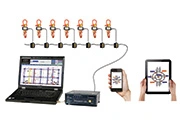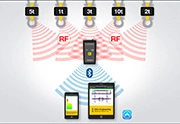The Ron StageMaster PRR (Portable Radio Receiver) is a compact and highly portable Bluetooth-compatible load monitoring system capable of monitoring up to 75 individual load cells from the convenience of an iPad or iPhone using the Ron StageMaster App.
Are you looking to weigh equipment in a bunch of different locations? Perhaps you are managing a venue and want to monitor all of the stage rigging, lights, speakers, etc. Eilon Engineering’s multi-point load cell systems are the devices for you. These systems conveniently allow you to monitor up to 200 load cells from a laptop, tablet, or cell phone.
While there are many different companies out there that offer load cells, Eilon Engineering stands out with over 45 years of experience in weighing applications, a market leading 5-year warranty, 0.1% accuracy, battery life from 2000 to 5000 hours, and a transmission range of up to 2 miles. Eilon offers an entirely wireless array of load shackles, dynamometers, load cells, and crane scales. Whatever your weighing needs might be, Eilon Engineering has you covered.
Eilon offers a wide array of different multi-point load cells, including shackle load pins, Eilon Classic in both wired and wireless varieties and a wire range of capacities The Ron StageMaster 6000G5 is a completely wireless load monitoring system with great battery life, high accuracy, and fatigue rated load cells. The Ron StageMaster 5000G4 is a wired multi-point load monitoring system that uses a single cable. The Ron Bluetooth Receiver is a compact Bluetooth compatible monitoring system that can easily be moved around. In addition to these multi-point load cell monitoring systems, the Eilon Classic Load Cell and the Shackle Pin Load Cell are easy to install and highly accurate Bluetooth compatible devices.
In one system you can combine different types of load cells, wired and wireless load cells, as well as different capacities.
So, what exactly are the benefits of using a multi-point load cell system? If you have a large structure (oftentimes like an arena, sports stadium, live concert or an exhibition) you will have lots of heavy equipment hanging across a pretty big distance. If this equipment ever were to fall, it could seriously injure or kill people. Perhaps you are raising and lowering equipment and want to measure the tension in the cabling. In these instances, you need a device that can measure the load on your stage rigging.
Stage rigging also suffers from the indeterminate structure problem. Any beam suspended from 3 or more points becomes nearly impossible to balance. It is mathematically impossible to calculate the load distribution across the suspension points. The only means of ensuring that loads are evenly distributed is to directly measure the force on each of the points using a load sensing instrument such as a load cell.
If you are looking to purchase a multi-point load cell system, there are several things you will need to consider. We’ve put together a short list to help you as you are shopping around. Here are the most common things to think about:
- How many load cells do I need?
- What type of load cell do I need?
- What is the most force I ever expect the load cell to measure?
- What kind of accuracy do I need?
- How can I interface with the load cell?
- What are the distances I need to cover?
- Should I choose a wired or wireless solution?
The first thing to consider is how many load cells you need. You will need to determine exactly how many places you want to use load cells. Also remember, that you want to purchase a system that is easily expandable. At the moment, you might only need 20 load cells. In a few years, you may have a need for 50. You want to be sure your system can easily expand to handle more load cells. Max. no. of load cells transmitting to one receiver and seen on one screen as a real time laid map: 200
Next, you need to consider what type of load cell you need. There are a lot of different kinds of load cells out there. For most staging needs, a crane scale load cell or a dynamometer are needed. There are also a wide variety of pancake, torque, and shear beam load cells. Determining what works best for your application is next.
Specific load cells are rated to specific force ranges. The internal circuitry and signal conditioning of the device will prevent it from continuing to change its output with force after a certain point. In addition, the physical design of the load cell will only be able to withstand so much force before it breaks. Being sure you specify the right force range for your load cell is crucial. Load cells should never be overloaded, choosing the right capacity is critical to ensure safety.
Next, you need to consider what kind of accuracy you need out of your load cell. Load cell accuracies are often specified as a percentage of the full scale (full scale being the maximum force that the load cell can measure). For example, if you have a 100 lbs load cell with 0.1% accuracy, your readings will be within 0.1 lbs of the true weight. Based on your specific needs, you will need to determine what level of accuracy is acceptable. A load cell with high accuracy is crucial for early detection of overloads.
It’s important to consider how you can interact with the load cell. Will you need external signal conditioning to convert the mv/V output to a more readable analog or digital signal? Will you need to incorporate PLCs or some other sort of device to read from it? How would I like for the load cell measurement to be displayed? A simple handheld or a complex real time load map?
Depending on the size and scope of the application load cells could potentially be installed across hundreds of meters. Attention must be paid to how far the load cells are from where they are meant to be monitored.
Depending on whether the load cells will be permanently installed or are part of a tour that requires frequent assembly/disassembly you may prefer a wireless system over a wired one. A wired system would not require that each load cell be battery powered but it would be disadvantageous should frequent disassembly be required. A wireless system would be supremely flexible and easy to handle, the downside would be that the batteries in each load cell would need to be replaced every so often. A combination of wired and wireless load cells is ideal for some applications.
Let Eilon Engineering Solve These Problems For You
Why not work with Eilon Engineering on these questions? You can provide the answers to the questions that you know, and our engineers can fill in the rest. With our 45 years of expertise, and with customers like NASA, Boeing and Cirque du Soleil, Las Vegas Convention Center, we can easily get you set up with one of our industry-proven multi-point load cell solutions that checks all the boxes.





.jpg)









.png) Barcelona Jan 30-Feb 2
Barcelona Jan 30-Feb 2